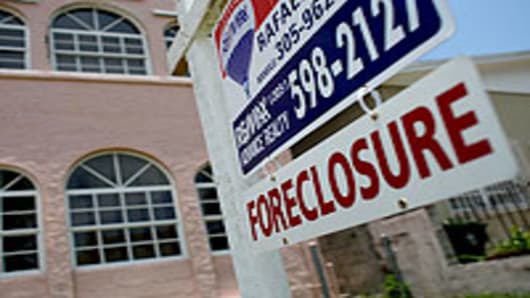In an unexpected reversal, both newly started foreclosures and finalized foreclosures dropped precipitously in February.
So-called foreclosure starts fell 15.2 percent month-to-month. Foreclosure sales, the final stage of the process (not sales of already bank-owned properties) fell 19 percent month-to-month, according to a new report from Lender Processing Services.
Most had expected both starts and sales to ramp up, following the $25 billion dollar settlementbetween five of the nation's largest banks and state attorneys general and federal agencies over the now infamous "robo-signing" scandal. The drop in finalized foreclosures was nationwide, in states where a judge is involved in the process as well as in non-judicial states.
"For both foreclosure starts and sales, we’re finding that so far, the sustained increase isn’t there, though we do see sporadic ‘bursts’ of activity," says Herb Blecher of LPS Applied Analytics. "These are sometimes focused around particular investors (i.e., Fannie Mae and Freddie Mac foreclosure starts) and may reflect seasonal trends, loss-mitigation activities, legislative impacts, or other operational factors. We can't say specifically what those bursts correlate to, because we just don’t see that in the data."
This sudden stall, however, if prolonged, could lead to an overall drop in home sales, given that foreclosures are such a large share of the market. That has at least one well-known analyst warning of more problems ahead for housing.
"Through relentless meddling with delusions that ‘foreclosures are bad,’ they effectively destroyed the macro housing market," says California-based mortgage analyst Mark Hanson, referring to government intervention in the housing market. "Contrary to popular thinking, the eradication of foreclosures will lead this housing market into paralysis, not recovery."
Hanson claims that the lack of ready and available distressed supply, "portends big trouble" for the overall housing market, but more pointedly for California, Nevada and Arizona, where distressed supply and sales are the bulk of the market.
"It will soon become apparent that 'foreclosure prevention' was one of the biggest housing and finance policy blunders of all time. That's because it circumvented interest rate policy in part aimed at household de-leveraging, kicked the problem forward and spread it out over many more years."
The drop in foreclosure starts and sales is likely due to the big banks trying to modify more loans under the settlement agreement, and in some cases dropping loan principal. Some of the modifications, claims Hanson, are even more "exotic" than the loans borrowers defaulted from in the first place, like 2 percent interest-only loans, 40 year amortizations, 33 percent forbearance, and five-year fixed rate loans. This as more than 11 million borrowers (22 percent of homeowners with a mortgage) owe more on that mortgage than their homes are currently worth, so-called "underwater."
"Legacy borrowers are now more levered than ever," worries Hanson.
Distressed sales, which include foreclosures and short sales (when the home is sold for less than the value of the mortgage) now make up just over one third of all existing home sales nationally, according to the National Association of Realtors, but more than half of all sales in California and other states hardest hit by the housing crash. Investors are rushing in to buy up all these properties, hoping to cash in on what is fast becoming an historic rental market.
In an effort to entice large investors to buy more properties and rent them out, the Federal Housing Finance Agency, regulator of Fannie Mae and , recently launched a pilot program, offering 2,500 foreclosed properties on the GSE's books for sale in bulk discount deals. Bank of America also just announced a program to turn troubled borrowers into renters, offering deeds in lieu of foreclosure to borrowers who would like to stay in their homes.
Both bulk sales and an intensified drive to modify more troubled loans will drain the supply of distressed properties on the market, leaving little for individual investors and first time home buyers with cash. They had been helping to put a floor on home prices, by increasing competition in the space. With the non-distressed market still running far behind normal volumes, a dramatic surge in non-distressed sales would have to occur to make up for the drop in distressed sales.
Given how many homeowners are stuck in place due to negative equity, and with home prices still falling annually, not to mention still-weak consumer sentiment in housing, that surge is highly unlikely.
Questions? Comments? RealtyCheck@cnbc.comAnd follow me on Twitter @Diana_Olick



